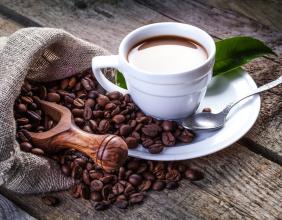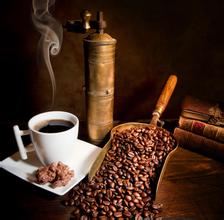Introduction to the characteristics and treatment methods of coffee flavor description of Indonesia Fuyin Manor with strong texture
Indonesia is also the producer of the world's most expensive coffee, known as Kopi Luwak. The historical origin of Kopi Luwak is as interesting as its taste. The authentic Kopi Luwak collects the droppings of wild raccoons (common raccoons, coconut raccoons), which are nocturnal in coffee plantations, foraging for well-ripe coffee beans. But it can't digest stones, coffee shops and cherries, so these cherry stones and coffee beans pass through the intestines and stomachs of these raccoons. Coffee farmers then collect and wash the coffee beans. The process of fermenting coffee beans in the raccoon's stomach breaks the coffee protein and takes away the bitterness, making the Kopi Luwak silkier, pristine and chewy. The low acidity of Kopi Luwak can also be easily absorbed by stomach ulcers and people with digestive problems.
Java coffee beans have now lost their proud name: mocha-Java, because in the early 1970s, farmers cut down traditional coffee trees and planted some high-yield and high-profit coffee beans. In Java, most coffee beans are dried by high-temperature machines, so they have lost the authenticity of the coffee, and the sour taste is obvious after roasting, so it can be said that it is difficult to find high-quality Arabica beans in Java.
Many people do not know what kind of Flores AP coffee bean is, in fact, it is "Luobada" coffee bean, this coffee bean is pure, and the sour taste is not high, in Europe, Italy, France, Switzerland and other countries like to use it to make "Italian extra strong espresso" mixed with, the author has tried a single drink is also good taste of Sumatra Mantenin coffee beans half are "washed" beans, and the other half will be "air-dried" beans The sale of raw beans is so ugly that many novice coffee roasters misunderstand its appearance and think they have been cheated. But when Mantenin coffee beans are roasted, especially after deep roasting, their appearance is rich and round, with a strong texture, and the coffee oil on the surface is also very attractive, with the smell of fructose syrup, strong taste with some bitterness, and strong and special aroma. In addition, Manning can help digestion, is a full of masculine coffee. Sumatra also has another type of water-washed beans called "Chiyushan GayoMountain". This coffee bean is grown from connected coffee trees and is not produced in large quantities, so it is not recognized by many people. After baking, it has the spice flavor of cloves and cardamom, and tastes good.
Among the Asian coffee-producing countries, Indonesia is a very noteworthy one. Indonesia is an island country in the Indian Ocean, the islands are distributed on both sides of the equatorial line, of which three islands: Java, Sumatra and Sulawesi produce the world's important coffee. In the mid-17th century, the Dutch brought coffee trees to Ceylon (Sri Lanka) and Java, Indonesia. In the 18th century, Indonesia became a major producer of coffee, and almost all of its high-quality Arabica coffee was supplied to Europe. But by the 19th century, coffee rust, which appeared in Ceylon in 1869, also affected Indonesia. By 1877, most of the coffee fields on the Indonesian islands had been damaged by rust, and the Dutch had to import other coffee varieties from Africa, namely Romsda coffee. It is more resistant to diseases and insect pests, but its quality is inferior. About 90 per cent of Indonesian coffee is Romda beans, about 6.8 million bags a year, and less than 10 per cent of beans are Arabica coffee.
Coffee produced in Indonesia generally does not have the name "Indonesia", but directly bears the name of the island, such as Java, Sumatra and so on.

Important Notice :
前街咖啡 FrontStreet Coffee has moved to new addredd:
FrontStreet Coffee Address: 315,Donghua East Road,GuangZhou
Tel:020 38364473
- Prev

Introduction to the characteristics of flavor description of coffee manor in Arusha, Tanzania with refreshing acidity
Tanzania covers an area of 945087 square kilometers, of which Zanzibar is 2657 square kilometers. It consists of the mainland, Zanzibar and more than 20 small islands. Located in eastern Africa and south of the equator, the continent is bounded by the Indian Ocean to the east, Zambia, Malawi and Mozambique to the south, Rwanda, Burundi and the Democratic Republic of the Congo to the west, and Kenya and Uganda to the north. The coastline of the mainland is 840 kilometers long.
- Next

The method of describing the flavor of the coffee producing area of La Tisa Manor in Guatemala
Coffee was really introduced into Guatemala in 1750 by Father Jesuit, and the coffee industry was developed by German colonists at the end of the 19th century. Today, most of the coffee industry's production takes place in the south of the country. There are seven major coffee producing areas in Guatemala, and the flavor of the coffee produced in each area is different, but to sum up, the coffee in Guatemala is all
Related
- Does Rose Summer choose Blue, Green or Red? Detailed explanation of Rose Summer Coffee plots and Classification in Panamanian Jade Manor
- What is the difference between the origin, producing area, processing plant, cooperative and manor of coffee beans?
- How fine does the espresso powder fit? how to grind the espresso?
- Sca coffee roasting degree color card coffee roasting degree 8 roasting color values what do you mean?
- The practice of lattes: how to make lattes at home
- Introduction to Indonesian Fine Coffee beans-- Java Coffee producing area of Indonesian Arabica Coffee
- How much will the flavor of light and medium roasted rose summer be expressed? What baking level is rose summer suitable for?
- Introduction to the characteristics of washing, sun-drying or wet-planing coffee commonly used in Mantenin, Indonesia
- Price characteristics of Arabica Coffee Bean Starbucks introduction to Manning Coffee Bean Taste producing area Variety Manor
- What is the authentic Yega flavor? What are the flavor characteristics of the really excellent Yejasuffi coffee beans?

